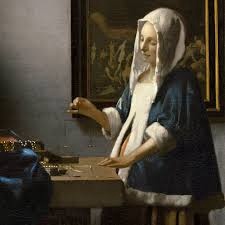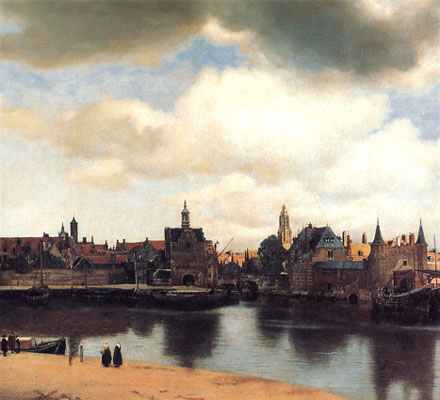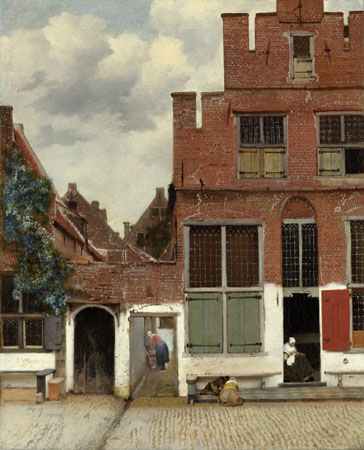Nick
Catalano is a TV writer/producer and Professor of Literature
and Music at Pace University. He reviews books and music for
several journals and is the author of Clifford
Brown: The Life and Art of the Legendary Jazz Trumpeter,
New York
Nights: Performing, Producing and Writing in Gotham
and A
New Yorker at Sea. Nick’s reviews are available
at www.nickcatalano.net
Autumn
in New York and the arrival of Vermeer’s “Girl with
a Pearl Earring” at the Frick
Museum. Across town at the Lincoln Center’s
New York film festival a documentary film dubbed Tim’s
Vermeer. Dutch architecture from New Amsterdam’s
17th century settlements permeating the neighbourhoods of every
borough (I drive past Spuyten Duyvil every day). “Skills”
townships i.e. Peekskill and Cobbleskill surrounding Gotham.
Rip Van Winkle smiling on billboards and a new series -- The
Legend of Sleepy Hollow - on TV.
The
legacy of the Dutch golden age has never left and one of its
famed artists is presently getting a big buzz all over town.
The Frick exhibition, entitled Vermeer, Rembrandt, and Hals
-- Masterpieces of Dutch Painting from the Mauritshuis, has
been a must see since its opening in late October. The star
of the show is, of course, Vermeer’s “Dutch Mona
Lisa.”  She
has risen to the top of art world since the release Peter Webber’s
2004 film Girl with a Pearl Earring starring Scarlett
Johansson based on the best-selling 1999 novel by Tracy Chevalier.
She
has risen to the top of art world since the release Peter Webber’s
2004 film Girl with a Pearl Earring starring Scarlett
Johansson based on the best-selling 1999 novel by Tracy Chevalier.
The
Frick exhibition is timely coming on the heels of the re-opening
of the Rijksmuseum (after a 10 year renovation) in Amsterdam.
The entire second floor of the breathtaking Rijksmuseum is devoted
to the Dutch golden age and it is enormously compelling (I delayed
my trip home for two days last summer). But the “Dutch
Mona Lisa” has always resided in the less frequently visited
Mauritshuis in The Hague so the Frick scored quite a coup and
art lovers are lined up outside every morning waiting to see
her.
For
Vermeer buffs who have seen Webber’s film the ‘real
thing’ is a bit disappointing because it has faded somewhat
and they’ve become used to Vermeer’s incomparable
colors as seen on the movie screen and on posters everywhere.
On the other hand, the exhibition is particularly valuable because
of genre paintings by Vermeer’s Delft School colleagues
Carel Fabritius (a member of the St. Luke’s painter’s
guild where Vermeer was headmaster), Jan Steen (whose painting
“As the Old Sing, So Pipe the Young” replicates
Vermeer’s domestic chamber compositions) and Nicolaes
Maes (whose painting “The Old Lacemaker” employs
Vermeer-like approaches to light). Other Delft schoolers Pieter
Claesz, Gerard ter Borch and Jacob van Ruisdael, who lived and
worked in towns a stone’s throw from Delft, are also represented
so visitors can learn volumes about genre painting by referencing
these lesser known Dutch masters. In addition, the Rembrandt
and Hals masterpieces reflect other features of the golden age
providing more bonuses for Frick patrons.
A fresh
injection of literature, i.e. the Frick catalogue, contains
the latest scholarship on the age old controversy surrounding
Vermeer’s use of a camera obscura (first published edition
of it in 1544 by Reinerus Gemma Frisius) and/or various lenses.
For a long time now there has been little doubt that he had
access to the latest optic inventions; the Dutch were avid lens
makers. Vermeer’s next door neighbour (and an executor
of his estate) Antoine van Leeuwenhoek (referred to as the Father
of Microbiology) was a master lens maker; the illustrious philosopher
Baruch Spinoza (b. 1632-the same year as Vermeer) made his living
grinding lenses. So many painters before Vermeer (van Eyck,
Lotto, Caravaggio, Velasquez, da Vinci) and after him (van Wittel,
Ingres) have been known to employ lens technology. It is a well-worn
subject.
However,
due to the explosion of Vermeer’s popularity it is he
who receives most of the press in the lens debates. The suggestion
that anyone who utilizes lens technology is somehow ‘cheating’
has too often accompanied art commentary. Critic David Bull
notes that Vermeer’s use of a camera obscura or convex
lenses is a way of “enriching what he is seeing.”
It is this point which is often lost in the continuing controversy.
Nevertheless,
Tim Jenison, in a new documentary Tim’s Vermeer,
has once again taken up the argument. Jenison, a successful
inventor/entrepreneur, revives the art vs. optics technology
issue in Vermeer’s work. He spends some seven months building
a replica of Vermeer’s room, setting up convex lens apparatus
and then painstakingly (213 days) painting what he sees through
the lens. Because his finished painting is Vermeer-like he concludes
that the photographic quality of Vermeer’s images could
only have been achieved with the aid of the lens technology.
The film is entertaining with comic/illusionist Penn Jillette
inserting humorous commentary about Jenison’s unwavering
dedication. It also provides fodder for the relationship between
art and science that many experimenters such as Jenison have
long been anxious to connect. That relationship was not a point
of controversy in ancient classical times (Aristotle was a philosopher/
mathematician/ biologist/aesthetician etc.) or in the Renaissance
(Da Vinci also moved naturally between arts and sciences). But
since the utilitarianism in the 19th century and the age of
specialization in the 20th, technology-in-art polemics have
raged .
The
film has succeeded in fanning the flames of the camera obscura
theory which one movie critic has dismissed as “wackadoodle.”
To bolster their aim for verisimilitude the producers quickly
usher on and off camera two veteran Vermeer commentators: Philip
Steadman and David Hockney, who give tacit assent to the possibilities
that Jenison introduces.
Still,
the camera obscura phenomenon can justifiably be brought into
an analysis of Vermeer and other artists; however, those desiring
to learn about Vermeer’s magic must focus on other  aesthetic
features. Initially, the reference to his photographic realism
that Jenison and others have used is bogus. Even cursory examination
of Vermeer’s work reveals blended and misted lines as
essential elements. In “Girl with a Red Hat” (1665-67)
the colourings that interfuse on the subject’s face help
us penetrate the narrative of her character.
aesthetic
features. Initially, the reference to his photographic realism
that Jenison and others have used is bogus. Even cursory examination
of Vermeer’s work reveals blended and misted lines as
essential elements. In “Girl with a Red Hat” (1665-67)
the colourings that interfuse on the subject’s face help
us penetrate the narrative of her character.  The
same misted effect is viewable on the finger of the figure in
“Woman Holding a Balance” (1662-65) which is deliberately
out of focus.
The
same misted effect is viewable on the finger of the figure in
“Woman Holding a Balance” (1662-65) which is deliberately
out of focus.
Vermeer
often distorts or adjusts reality in order to further his vision
and this circumstance poses a direct challenge to the camera
obscura crowd. In “The Art of Painting” (1666-68)
he simply leaves out the left leg of the easel and in “The
Little Street” he distorts the window shutter space. His
indefatigable search for the subtle effect of light propels
his avant-garde employment of pointillism to highlight crusts
of bread in “The Milkmaid” (1658-61) and the freeboard
of the ship in “View of Delft” (1660-61).
Vermeer’s
activism in using the pin-hole method to determine vanishing
points is observable in  “The
Music Lesson” (1662-64) and other paintings. This technique
helps us understand his innovation in compositional placement.
Discernible illusions of texture are seen in the roofs and brick
sidings in “View of Delft” and this leads us to
investigate his captivating wet-on-wet process which allows
him to achieve the colour drama he is so noted for. The tonal
effects produced by the coloured undermodeling show through
the paint in various places and can be analyzed.
“The
Music Lesson” (1662-64) and other paintings. This technique
helps us understand his innovation in compositional placement.
Discernible illusions of texture are seen in the roofs and brick
sidings in “View of Delft” and this leads us to
investigate his captivating wet-on-wet process which allows
him to achieve the colour drama he is so noted for. The tonal
effects produced by the coloured undermodeling show through
the paint in various places and can be analyzed.
As
I noted before, harnessing light is central to the skill of
Vermeer. He is best known for his manipulation of light reflections,
refractions and shadowing. The effects of these wondrous achievements
are seen on the wall of “Woman Holding a Balance,”
on the chandelier of “The Art of Painting” and many
other places.
These
factors – the distortions of nature, the manipulation
of light, the imprecise lines, the wet-on-wet tonal attainment,
and the textural nuances – make nonsense out of the photographic-realism/
technology issue.
What
must also be noted in the continuing saga of the mystery of
Vermeer and his art is the evolution of his status. It begins
ignominiously enough. Although he was accorded praise by some
of his contemporaries, his work was virtually ignored for 200
years after his death. Finally, in 1866, a French art critic
Theophile Thore published an article praising the then unknown
Dutch genre painter from Delft. He would later publish a catalogue
of Vermeer’s work although many of the paintings he attributed
to Vermeer were later proven to have been executed by others.
In 1881 an art historian/collector Victor de Stuers persuaded
his friend Arnoldus des Tombe to bid on the  unknown
work “Girl with a Pearl Earring” at an auction.
Tombe was able to purchase the painting for 2 guilders plus
the buyer’s premium of 30 cents.
unknown
work “Girl with a Pearl Earring” at an auction.
Tombe was able to purchase the painting for 2 guilders plus
the buyer’s premium of 30 cents.
From
this time on Vermeer’s art began an ascendency. Eighteen
eighty-five collector Abraham Bredius (later director of Mauritshuis)
was the first to praise “Girl with a Pearl Earring”
in public. Marcel Proust in his titanic 1913 novel In Search
of Lost Time has one of the characters – a novelist
Bergotte – collapse and die while looking at the “View
of Delft.” As collectors began to flock, the Vermeer oeuvre
started to command higher prices; one of the reasons was the
actual rarity of his paintings (at this writing the number stands
at 36). Between 1901 and 1919 Henry Clay Frick purchased three
Vermeers for his New York home which has now become Frick museum.
Still,
there were twists and turns in the evolution of Vermeer’s
reputation. Several of his paintings were ascribed to other
artists – a pattern quite common when artists begin to
get noticed. In 1937, Bredius announced the discovery of a new
Vermeer masterpiece “Supper at Emmaus” but in 1945
an unsuccessful Dutch artist, Hans van Meegeren, who had been
imprisoned on a charge of collaborating with the Germans during
the Nazi occupation of Holland, confessed that he had forged
the painting along with several other bogus Vermeers. During
this period another Vermeer aspirant seized “The Art of
Painting from a collection in Vienna. His name was Adolf Hitler.
The
role of art collectors, critics and dealers in the changing
status of Vermeer’s reputation is certainly not an uncommon
case. Any art historian will point to the maneuvering of impressionistic
art in France in the late 1800s by art dealers who understood
the vagaries of notoriety and publicity. Monet, Renoir, Pissarro,
Degas, Manet et al. had their own rebel Salon des Refusés
in the 1870s and 1880s opposing that of the Académie
de Beaux Arts. This anti-Salon received lots of pejorative publicity,
but as the Mad Men have long said any publicity is good publicity,
Thus, when the clever art dealer Paul Durand-Ruel and other
shrewd sellers started hyping the impressionists and drawing
upon their ersatz celebrity they created a craze and collectors
and art lovers began to swarm to the Monets and Renoirs. The
rest, of course, is history.
In
the background of the story of Vermeer and his critics sits
a larger narrative – that of the ebb and flow of artistic
reputations and, in our own age, the preposterous monies paid
for art which may someday become unfashionable. But that is
an issue for future writing.